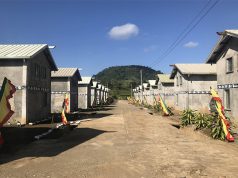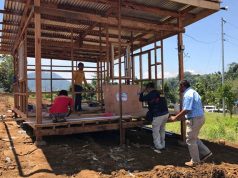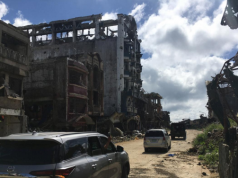MANILA – On Tuesday, July 4, the Supreme Court voted, with one dissent, to uphold the constitutionality of President Duterte’s 60-day martial law proclamation in Mindanao. Chief Justice Sereno was one of three who voted to uphold, but partially–limiting it only to Marawi City.
Here’s how the SC Public Information Office summarized her opinion:
The Chief Justice voted to partly grant the petitions, stating that sufficient factual basis existed only insofar as three provinces are concerned. Her vote is indicated in her Dissenting Opinion, as follows:
“Accordingly, I vote to declare that the President had sufficient factual basis for the issuance of Proclamation No. 216 only insofar as it covers the following provinces: Lanao del Sur, Maguindanao, and Sulu.
Proclamation No 216 should be struck down insofar as it covers the following provinces and cities: Agusan del Norte, Agusan del Sur, Basilan, Bukidnon, Butuan City, Cagayan de Oro City, Camiguin, City of Isabela, Compostela Valley, Cotabato City, Davao City, Davao del Norte, Davao del Sur, Davao Occidental, Davao Oriental, Dinagat Islands, General Santos City, Iligan City, Lanao del Norte, Misamis Occidental, Misamis Oriental, North Cotabato, Sarangani, South Cotabato, Sultan Kudarat, Surigao del Norte, Surigao del Sur, Tawi-Tawi, Zamboanga City, Zamboanga del Norte, Zamboanga del Sur, and Zamboanga Sibugay.
The Petitions are hereby accordingly PARTLY GRANTED.”
1. In her dissent, the Chief Justice points out that the record of these cases shows that the President did not have sufficient factual basis to declare martial law and suspend the privilege of the writ of habeas corpus throughout the entirety of Mindanao. She concedes that factual basis exists for the President’s action, whether reckoned from the date he issued Proclamation No. 216 or from the date of this opinion, to support such a proclamation and suspension only for the City of Marawi and that no amount of strained reading of the two presidential documents—Proclamation No. 216 and the President’s Report to Congress—come close to a claim that rebellion is taking place anyehere else outside of Marawi City.
However, she explains that, in examining the sufficiency of the factual basis for martial law, she took the process one step further by examining the totality of the President’s claim that the whole of Mindanao is vulnerable to the ISIS-inspired rebellion led by the Maute Group and to listen very carefully to the account of the realities on the ground as disclosed by the Secretary of National Defense and the Armed Forces of the Philippines Chief of Staff.
2. The Chief Justice’s conclusion is that, at most, martial law can only be justified in three provinces—Lanao del Sur of which Marawi is a part; Maguindano and Sulu, where significant support from the Bangsamoro Islamic Freedom Fighters (BIFF) and the Abu Sayyaf Group (ASG) are coming from.
In her view, the unconstitutionality of declaring martial law over the entire island group of Mindanao arises not because there is no violence in other areas of Mindanao because there is; neither is it because the dangers posed by the Maute fighters are not serious because they are. These incidents of violence and conflict, outside of Marawi City, however do not amount to the actual rebellion that can form a “sufficient factual basis” for the declaration of martial law or the suspension of the privilege of the writ of habeas corpus.
3. The Chief Justice also emphasized that the approach she took in analyzing the facts and evidence presented is a pro hac vice approach considering the sui generis nature of the review. She examines the totality of the evidence presented and arrived at the conclusion that there is sufficiency of factual basis only to justify the proclamation and the suspension for three provinces.
4. The Chief Justice also took exception to the ponencia’s arguments on the following points:
a. The Court’s duty to inquire into the necessity of declaring martial law to protect public safety logically and inevitably requires the determination of proportionality of the powers sought to be exercised by the President. This means that the greater powers are needed only when other less intrusive measures appear to be ineffective.
b. The duty of the Court to inquire into the necessity of declaring martial law to protect public safety logically and inevitably requires the definition of the metes and bounds of the areas to be covered by martial law. If martial law is not necessary to protect public safety in a certain locality, then that locality cannot be included in the coverage of martial law.
c. Contrary to what the ponencia says, it is possible to define the territorial boundaries of martial law. No less than Article VII, Section 18 provides for this.
d. When the Court makes a determination in the area coverage of martial law, it does not substitute its wisdom for that of the President, nor its expertise in military strategy for the military’s. The Court has to rely on the allegations put forward by the President and his subalterns and on that basis apply a trial judge’s reasonable mind and common sense on whether the sufficiency and necessity tests are satisfied. The Court cannot start defending vigorously its power to review with respect to sufficiency and later default when it comes to necessity.
5. The Chief Justice then suggests some Parameters for the Implementation of Martial Law and the Suspension of the Privilege of the Writ of Habeas Corpus taking into account relevant constitutional inhibitions, statutory restrictions, and consequences on existing laws defining crimes and felonies.
Below, full text of her opinion:









